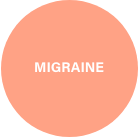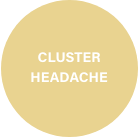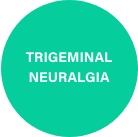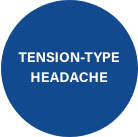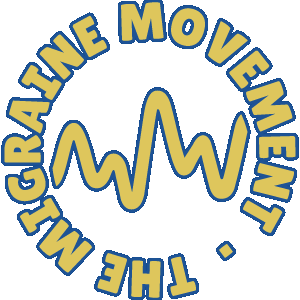What is headache?
Common neurological disorders
Headache disorders are among the most common neurological disorders. These include tension-type headache (TTH), migraine and chronic daily headache syndromes as well as the more rare disorders, cluster headache and trigeminal neuralgia.
Underestimated and under-diagnosed
Headache has been, and continues to be, underestimated in scope and scale and headache disorders remain under-diagnosed and under-treated throughout Europe. In terms of funding and research, despite its prevalence, headache is often overlooked by key decision makers.
Top ten leading causes of disability
Not only is headache painful, but headache disorders are also disabling. Worldwide, according to the World Health Organisation (WHO), migraine alone is one of the top ten leading causes of disability and affects 12-15% of the population.
ECONOMIC IMPACT
Headache disorders impose both a social and financial burden on many sufferers. Repeated headache attacks, and often the constant fear of the next one, damage family life, social life and work life. In Europe, migraine alone costs the economy €27 billion annually in reduced productivity and work days lost according to the 2006 Cost of Brain Disorders in Europe paper.

Headache is the most prevalent neurological symptom and is experienced by almost everyone. Headache can be a symptom of a serious life-threatening disease, such as a brain tumor, but in most cases, it is a benign disorder that comprises a primary headache such as migraine or a tension-type headache (TTH). Nevertheless, migraine and TTH can cause substantial levels of disability, not only to patients and their families but also to society as a whole owing to its high prevalence in the general population.
Primary headaches are highly prevalent, disabling, underestimated: up to 1 adult in 25 has headache every or nearly every day. WHO classified migraine alone as 19th among all causes of years lived with disability (YLD). All headache disorders together are possibly in the top 5 causes of disability worldwide.
TTH is the most common form of headache and is often thought of as a normal headache, in contrast to debilitating and characteristic migraine attacks or cluster headaches. Owing to its high prevalence, disability due to TTH is greater than that for migraine at the population level. Headache is among the ten most disabling disorders for both sexes and if the burden of TTH is taken into account, among the five most disabling disorders for women, in accordance with the WHO’s ranking of the most disabling disorders.
Limited data is available so far on headache disorders. In 2004 WHO identified headache as the most frequently reported neurological disorder in primary care in Europe.
The ECHI (European Community Health Indicators) project, funded by the Public Health Programme, has compiled generic data on migraine or frequent headaches only including 12-month prevalence, by gender, age, region, SES (Socio Economic Status) and the WHO Atlas on Country resources has focused on the compilation of data on the frequency of primary and secondary care of headache in Europe. To date, only pharmaceutical companies have drawn-up some evaluation on parts of the global burden of headache. There is no data at European level on prevalence and global impact of headache.
Migraine alone costs the economy €27 billion annually in reduced productivity and work days lost.
TYPES OF HEADACHE
Migraine
Migraine is a primary headache disorder, probably with a genetic basis. Activation of a mechanism deep in the brain causes release of pain-producing inflammatory substances around the nerves and blood vessels of the head. Why this happens periodically and what brings the process to an end in spontaneous resolution of attacks are uncertain.
Usually starting at puberty, migraine is recurrent throughout life in many cases. Adults with a migraine describe episodic attacks with specific features, of which headache and nausea are the most characteristic. In children, attacks tend to be shorter-lasting and abdominal symptoms more prominent. Attack frequency is typically one or twice a month but can be anywhere between once a year and once a week, often subject to lifestyle and environmental factors.
Migraine is different from a normal or tension-type headache. Both cause pain, but migraine is a real medical condition like asthma, diabetes or epilepsy. Migraine is a neurological condition.
MOST COMMON TYPES OF MIGRAINE
The headache is usually on one side of the head with a throbbing or pulsating pain.
Attacks of headache and accompanying symptoms may last between 4 and 72 hours when untreated or unsuccessfully treated.
The patient may also become sensitive to light and/or sound or smells.
These symptoms aggravate typically, along with headache, after any physical activity.
Atypically, the pain can occur in the cervical area or in the mandibular area.
People who experience this type of migraine will have many or all the symptoms of a ‘migraine without aura‘ as well as additional neurological symptoms which develop over a 5 to 20 minute period and last less than an hour, usually prior to headache phase.
The most common symptoms of migraine aura are visual disturbances such as blind spots in the field of eyesight, coloured spots, sparkles or stars, flashing lights before the eyes, tunnel vision, zig zag lines, temporary blindness.
A migraine aura that lacks the accompanying headache. Also called “The silent migraine”. The aura attack features temporary visual, sensory and/or speech/language symptoms.
The aura evolves over several minutes and generally lasts between 5 to 60 minutes. The aura symptoms are the same as in migraine with aura. Typical migraine aura without headache, despite a lack of head pain, can still be disabling for those who live with it.
Chronic migraine happens when the patient experiences more than 15 headache days per month, given that most of these headaches share migraine characteristics.
Usually, a chronic migraine sufferer has experienced occasional migraine episodes for years, and over time, that migraine becomes more frequent gradually.
Abdominal migraine consists primarily of abdominal pain, nausea and vomiting. Most children who experience abdominal migraine grow out of it by their teenage years and eventually develop migraine headaches.
In addition to the pain, there can be loss of appetite, nausea, vomiting and pallor.
Migraine attacks that occurduring the perimenstrual period most often: the pain may start up to two days before the bleeding to two days later.
This type of migraine is thought to affect fewer than 10% of women.
As with almost all types of migraine the diagnosis is clinical. Keeping a diary for at least three months recording both migraine attacks and menstruation days helps both the sufferer and the treating physician a lot.
Testimonials from the "Migraine Diagnosis" survey carried out in 2020 by The Migraine Movement reveal the frustration of atypical migraine patients.
After the survey, we concluded that patients with atypical cases appreciate that GP’s don’t give up their cases and continue in the search for an adequate diagnosis and treatment.
The Migraine Movement
Cluster Headache
SYMPTOMS
A cluster headache strikes quickly, usually without warning, although it might come with migraine-like nausea and aura first.
- Excruciating pain that is generally situated in, behind or around one eye, but may radiate to other areas of face, head and neck.
- One-sided pain
- Restlessness
- Excessive tearing
- Stuffy or runny nose on the affected side
- Forehead or facial sweating on the affected side
- Pale skin (pallor) or flushing on your face
- Swelling around your eye on the affected side
- Drooping eyelid on the affected side
Some migraine-like symptoms —including sensitivity to light and sound— can occur with a cluster headache, though usually on one side.
DURING A CLUSTER PERIOD
- Headaches usually occur every day, sometimes several times a day.
- A single attack can last from 15 minutes to three hours.
- The attacks often occur at the same time each day.
- Most attacks occur at night, usually one to two hours after you go to bed.
- After attacks, most people are pain-free but exhausted.
CAUSES
The exact cause of cluster headaches is unknown, but cluster headache patterns suggest that abnormalities in the body’s biological clock (hypothalamus) play a role.
RISK FACTORS
SEX
Men are more likely to have cluster headaches.
AGE
Most people who develop cluster headaches are between ages 20 and 50, although the condition can develop at any age.
SMOKING
Many people who get cluster headache attacks are smokers. However, quitting smoking usually has no effect on the headaches.
ALCOHOL USE
If you have cluster headaches, drinking alcohol during a cluster period may increase your risk of an attack.
A FAMILY HISTORY
Having a parent or sibling who has had cluster headache might increase your risk.
Trigeminal Neuralgia
“The prevalence of trigeminal neuralgia in the population is 0.07%, compared to approximately 2% in patients with facial pain in general.
Conversely, trigeminal neuralgia (also known as tic douloureux) is frequently mistaken for dental pain, leading to redundant diagnostic procedures such as x-rays of the jaw and, in more than a few cases, unnecessary extractions of teeth.
Accurate diagnosis of trigeminal neuralgia depends critically on the patient’s description of its characteristic features. Clarification of the characteristics of the pain is, therefore, necessary to guide clinical diagnosis and management. Successful diagnostic criteria must account for established variants of the phenotype (eg, typical versus atypical trigeminal neuralgia), incorporate symptoms or signs that correlate with different etiologies (primary trigeminal neuralgia versus trigeminal neuralgia secondary to a major neurologic disease), and identify pain features that indicate underlying pathophysiologic mechanisms (peripheral ver- sus central), as they are relevant to direct further investigations or treatment de- decisions (pharmacologic therapy versus surgery).”
Cruccu G. Trigeminal Neuralgia. Continuum (Minneap Minn). 2017;23:396-420
Tension-Type Headache
“Tension-type headache has distinct subtypes. Episodic tension-type headache, like migraine, occurs in attack-like episodes. These usually last no more than a few hours but can persist for several days. Chronic tension-type headache, one of the chronic daily headache syndromes, is present most of the time and can be unremitting over long periods. It is less common, but much more disabling to those affected.
Headache, in either case, is usually mild or moderate and generalized, though it can be one-sided. It is described as pressure or tightness, like a band around the head, sometimes spreading into or from the neck. It lacks the specific features and associated symptoms of migraine.”
Paolo Martelletti, Timothy J. Steiner (eds.), Handbook of Headache, Springer Milan Heidelberg Dordrecht London New York, 2011
Testimonials
AEPAC- Asociación Española de pacientes con cefalea
Members of the Spanish Association of Patients with Headache disorders AEPAC, tell their experiences with this disease.
EFNA
AUDREY CRAVEN
On World Brain Day 2017 (Saturday, July 22nd) we are encouraging patient advocates to share their stories. Video testimony created by the EFNA.
Dutch Association of Headache Patients (NVvHP)
A day in the life go a migraine sufferer.
How this illness limits her personal, social and working life.
